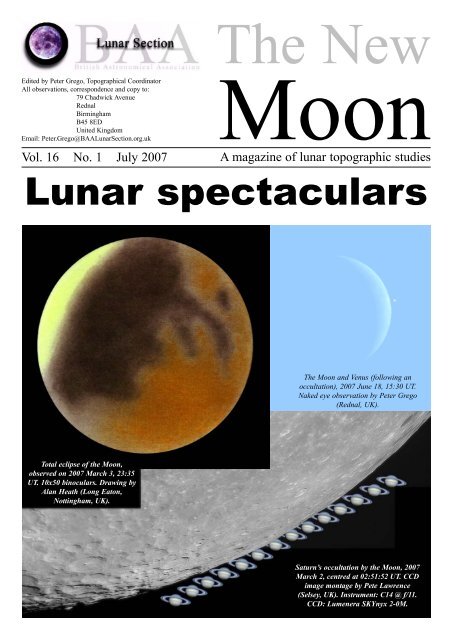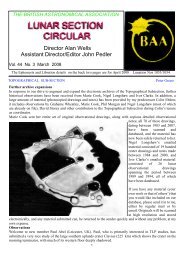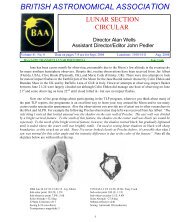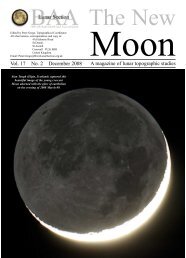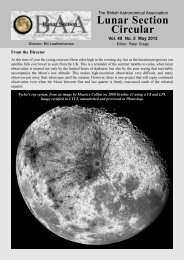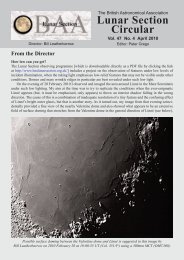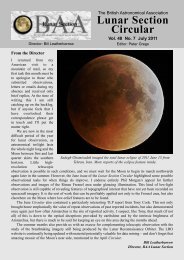You also want an ePaper? Increase the reach of your titles
YUMPU automatically turns print PDFs into web optimized ePapers that Google loves.
Edited by Peter Grego, Topographical Coordinator<br />
All observations, correspondence and copy to:<br />
79 Chadwick Avenue<br />
Rednal<br />
Birmingham<br />
B45 8ED<br />
United Kingdom<br />
Email: Peter.Grego@<strong>BAA</strong><strong>Lunar</strong><strong>Section</strong>.org.uk<br />
<strong>Vol</strong>. <strong>16</strong> <strong>No</strong>. 1 July 2007<br />
The New<br />
Moon<br />
A magazine of lunar topographic studies<br />
<strong>Lunar</strong> spectaculars<br />
The Moon and Venus (following an<br />
occultation), 2007 June 18, 15:30 UT.<br />
Naked eye observation by Peter Grego<br />
(Rednal, UK).<br />
Total eclipse of the Moon,<br />
observed on 2007 March 3, 23:35<br />
UT. 10x50 binoculars. Drawing by<br />
Alan Heath (Long Eaton,<br />
<strong>No</strong>ttingham, UK).<br />
Saturn’s occultation by the Moon, 2007<br />
March 2, centred at 02:51:52 UT. CCD<br />
image montage by Pete Lawrence<br />
(Selsey, UK). Instrument: C14 @ f/11.<br />
CCD: Lumenera SKYnyx 2-0M.
Mare Humboldtianum<br />
Point of<br />
maximum<br />
libration<br />
Mare Marginis<br />
Mare Smythii<br />
Mare Australe<br />
The 10 day old Moon. 2007 May 26,<br />
05:44 UT. Image by Maurice Collins<br />
(Palmerston <strong>No</strong>rth, New Zealand).<br />
Contents<br />
Papers<br />
3 The Messier craters and the Goodacre ‘ghost rings’ Phil Morgan<br />
Observations<br />
5 Messier and Messier A Phil Morgan<br />
9<br />
12<br />
The total lunar eclipse of 2007 March 3/4<br />
Humboldt<br />
Alan Heath / Lee Macdonald<br />
Colin Ebdon<br />
Images<br />
2 The 10 day old Moon Maurice Collins<br />
10 Santbech to Cook Mike Brown<br />
11 Torricelli to Messier / Theophilus, Cyrillus & Catharina Ed Crandall<br />
Page 2 The New Moon July 2007
The Messier craters and the Goodacre<br />
‘ghost rings’<br />
Phil Morgan<br />
Brief overview<br />
Situated on the western side of the Mare<br />
Fecunditatis, the Messier craters are well<br />
known to all lunar observers and need little<br />
in the way of introduction. Also the<br />
sometimes baffling morphology the<br />
craters undergo throughout the lunar day<br />
have been studied and reported by many<br />
observers since they were first discovered<br />
by Schroeter (1745-18<strong>16</strong>).<br />
Messier A (formerly Pickering) is the<br />
largest and also the deepest of the pair —<br />
in fact well over 300 metres deeper. It<br />
measures about 13 x 12 km and is situated<br />
some 7 km west of the much more elongated<br />
Messier crater. However, the eastwest<br />
diameter of Messier A is much more<br />
(13 x <strong>16</strong> km) if we include the shallow<br />
attached underlying ring to the west. For<br />
the purpose of this article I shall refer to<br />
this as ‘original Messier A’.<br />
The Messier crater itself was named<br />
after the famous French comet hunter of<br />
that name, thanks to the ‘comet tail’<br />
appearance of the two rays stretching<br />
westwards across the Mare Fecunditatis .<br />
The usual quoted diameter for this crater<br />
(also the one given in Rükl) is 9 x 11 km.<br />
However, Messier is an oblate ellipse, and<br />
one drawn to these dimensions just doesn’t<br />
look correct to me. Roughly measuring the<br />
orbiting spacecraft images I get a figure<br />
nearer 9 x 15 km, but would be interested<br />
to know what other members think about<br />
this.<br />
The rays and the Goodacre ‘ghost rings’<br />
Covering a distance of nearly 140 km and<br />
some 6 to 7 km across at their widest, the<br />
famous double ray or ‘comet tail’ stretches<br />
across the Mare Fecunditatis from Messier<br />
A towards Lubbock H. Some observations<br />
by the author indicate that the southern ray<br />
extends beyond Lubbock H over the highland<br />
terrain, but these uplands are so much<br />
brighter than the mare basalts that it’s<br />
always difficult to be sure.<br />
Lying between these rays Walter<br />
Goodacre believed he had discovered a<br />
chain of ghost craters. In the 9th <strong>BAA</strong><br />
<strong>Lunar</strong> <strong>Section</strong> Memoir he wrote:<br />
“....the course of the rays covers the site<br />
of five obscure crater rings, which have<br />
been reduced by erosion or other action to<br />
a state of obliteration. One crater shows<br />
the remains of a central peak.” Goodacre<br />
went on to say that these ghost rings are<br />
“only visible under certain conditions of<br />
phase, when they are not very difficult to<br />
see.”<br />
While many eminent lunar observers<br />
have searched for these old rings without<br />
success, I have over a period of time managed<br />
to rediscover at least some of these<br />
features mentioned by Goodacre.<br />
Hopefully the observations reproduced<br />
here will speak for themselves, but essentially<br />
I find four partial rings lying<br />
between the rays, not the five noted by<br />
Goodacre. Also, the second one westwards<br />
from Messier A is larger than the others<br />
and not completely bounded by the rays as<br />
he shows. Also he records the ring nearest<br />
Lubbock H as having the remains of a central<br />
peak, but I have (so far) failed to detect<br />
this.<br />
The rays themselves remain visible<br />
under very low angles of illumination at<br />
sunset, more so than most others, and I<br />
find that the southern ray is the first to<br />
fragment and break up before disappearing<br />
into the lunar night.<br />
Clementine high Sun images seem to<br />
indicate that Messier has fine filaments of<br />
ray material extending both north and<br />
Messier (at right) and Messier A,<br />
photographed in July 1969 on the<br />
Apollo 11 mission. Credit NASA.<br />
south away from the crater, that are difficult<br />
to confirm telescopically. That fact<br />
these are absent from the Messier A crater<br />
is probably due to the fact that the<br />
impactor landed between the walls of the<br />
already existing original Messier A.<br />
This still leaves the problem as to just<br />
how the ‘comet tail’ of rays were produced.<br />
In the past some have believed the<br />
rays to have originated from Messier, but<br />
as I pointed out in the <strong>Lunar</strong> <strong>Section</strong><br />
Circular (<strong>Vol</strong>ume 42, Number 6, June<br />
2005), a line drawn through the major axis<br />
of the Messier elongation emerges some<br />
way down the northern ray towards<br />
Lubbock H, giving a rotation clockwise of<br />
about four degrees from a line directly<br />
along the strike of the rays. Whilst this<br />
doesn’t completely rule out the theory, it<br />
does seem to make it unlikely. I will offer<br />
an alternative to this in the next section.<br />
One lump or two Two bumps or three<br />
It’s almost impossible to write about the<br />
Messier craters without at least touching<br />
on some of the possible theories for their<br />
origin. There are of course some that can<br />
be discounted at the outset, such as the one<br />
proposed by H H Nininger in the early<br />
1950s, describing the appearance of the<br />
The New Moon July 2007<br />
Page 3
Fig. 1<br />
Fig. 1. Observation by the author. 2005<br />
February 12. 305 mm f/5 Newtonian<br />
x400. Seeing 6/10. Transparency 4/5.<br />
Colong 314.32-314.57. <strong>No</strong>te the light<br />
strip connecting the two craters. Earlier<br />
observers believed this indicated a raised<br />
ridge connecting the pair. At this colongitude<br />
the Goodacre ‘ghost rings’ are just<br />
becoming visible.<br />
Fig. 2<br />
Fig. 2. Wanders.<br />
1949. The changing<br />
shape of the<br />
Messier (left)<br />
craters. Some of<br />
the shapes shown<br />
throughout a lunation<br />
are not confirmed<br />
by the<br />
author.<br />
Fig. 3. G. Fournier. 1913 December 2. 17:15. 19-inch OG. (stopped to 13 inches) x258.<br />
Colong 322.2°. Poor images. Some of the most detailed visual observations of the<br />
Messier craters were made by the two Fournier brothers between 1907 and 1913,<br />
working at the Jerry-Desloges Observatory in Algeria. Figs 3 and 4 were made simultaneously<br />
by the brothers and illustrate the inescapable subjectivity of visual studies,<br />
since there are obvious differences in the way they have recorded detail in and around<br />
the craters.<br />
Fig. 4. V. Fournier. 1913 December 2. 17:15. 11-inch OG (stopped to 8 inches) x225.<br />
Colong 322.2°. Image reasonably good with red filter. Made at exactly the same time<br />
as Fig. 3. <strong>No</strong>te the exaggerated triangular shape of Messier A compared to that of his<br />
brother. He also misses the line of shadow made by the secondary ring in Messier A.<br />
two craters as the opposite ends of a ‘tunnel’<br />
ploughed through a surface ridge by a<br />
body which blithely continued on its<br />
way....<br />
Having discovered his ‘obscure crater<br />
rings’ Goodacre believed he had found<br />
clear evidence for the true nature of the<br />
comet tail ray system. I can only surmise<br />
that by this he meant that the rays marked<br />
the site of two converging lunar faults and<br />
his chain of ghost craters had formed<br />
between them in progression from<br />
Lubbock H eastwards. At some point the<br />
Mare Fecunditatis lavas had flooded and<br />
inundated these craters, largely destroying<br />
them. After this crater forming activity<br />
continued along the chain with the formation<br />
of the original Messier A, then<br />
Messier A and finally the Messier crater<br />
itself. The rays themselves being the<br />
lighter ejecta from small craters situated<br />
along the ray faults.<br />
This is only my interpretation of what<br />
Goodacre meant, and while it does have<br />
some merits, I think it unlikely to have any<br />
supporters since it is now universally<br />
accepted that these craters are of impact<br />
origin, with the projectile(s) coming in at a<br />
very low angle (less than 5°) from the east.<br />
Disagreement steps in when deciding if<br />
there was one lump or two, or maybe even<br />
three.<br />
Fig. 3 Fig. 4<br />
Page 4 The New Moon July 2007
The New Moon July 2007<br />
Page 5
Fig. 5<br />
Fig. 5. Rob Moseley. 1986 February 13. 18:00 UT. 6-inch Cooke<br />
OG x172. Colong 322.7. Seeing IV. Transparency VG. Moseley<br />
was <strong>BAA</strong> <strong>Lunar</strong> <strong>Section</strong> Topographical Coordinator at the time<br />
and made many studies of the Messier craters.<br />
Fig. 6<br />
Fig. 6. W H Pickering. 1904. Pickering thought that the cause<br />
for the changes these craters undergo throughout the lunation<br />
was due to the deposition and evaporation of frost.<br />
Fig. 7. The author. 1973 December 8. 01:00-01:15 UT. 153 mm<br />
Grubb Parsons OG x270. Defn.good. An unusual observation by<br />
the author apparently showing two dusky stripes between the<br />
craters continuing the strike of the rays towards Messier. At the<br />
time I saw this as possible proof that the rays emanated from<br />
Messier and not A. Unfortunately, though, the observation has<br />
never been confirmed.<br />
Fig. 7<br />
In the ‘one lump’<br />
theory the incoming<br />
impactor<br />
grazes the lunar<br />
surface to produce<br />
the Messier crater,<br />
it then skips some<br />
10 km to produce<br />
A, the original A<br />
already being in<br />
existence (two<br />
bumps). Whilst in<br />
the ‘three bounce’<br />
theory the second<br />
‘bounce’ forms the<br />
original Messier<br />
A, it then rebounds<br />
back eastwards to<br />
finally produce<br />
Messier A (three<br />
bumps).<br />
I have several<br />
problems with this<br />
theory. Anyone<br />
who has skipped<br />
stones across a<br />
pond will know<br />
that each successive<br />
bounce is of<br />
reduced intensity.<br />
On the ‘three<br />
bounce’ theory we<br />
are expecting the<br />
last bounce to produce<br />
not only the<br />
largest crater but<br />
also the deepest.<br />
Also it’s difficult<br />
to understand how<br />
the impactor survived<br />
the first two<br />
bounces intact, but<br />
was completely<br />
vaporised on the<br />
final (and weakest)<br />
touchdown, leaving<br />
not a trace of<br />
its existence. The<br />
‘two lump’ theory<br />
(with the second<br />
one rebounding to<br />
form Messier A)<br />
doesn’t explain the<br />
depth of Messier<br />
A, nor the ray system.<br />
My own theory<br />
is that two meteorites<br />
came in low<br />
from the east, one<br />
slightly ahead of<br />
the other. The first<br />
one of these<br />
grazed the lunar surface to produce<br />
Messier, it then bounced 10 km westwards<br />
at a reduced velocity to make the similarly<br />
shaped original Messier A. The second<br />
projectile arrived a little later and slightly<br />
west of the first, striking the east rampart<br />
of the original Messier A, or just inside it;<br />
hitting this, it was unable to skip or bounce<br />
like its predecessor and produced a deeper<br />
and more normal shaped crater. Because<br />
of the low angle of its incoming flight, and<br />
it striking an already existing crater (original<br />
Messier A) material was sent violently<br />
westwards. But the west wall of original<br />
Messier A acted like a shield and blocked<br />
some of this, and indeed a small talus of<br />
material can still be seen lying in the interior<br />
of the remains of original A. But much<br />
was blasted either side of this shield to go<br />
on and produce the comet-like rays.<br />
Finishing on an observational note, the<br />
interior floor markings of Messier are fairly<br />
simple. An elongated dark strip with a<br />
median lighter band. But the Messier A<br />
markings are much more complex, indicating<br />
that the lunar bedrock was already<br />
disturbed when the second impactor<br />
struck. Also, the fact that A is not only<br />
larger but deeper than its so called ‘twin’<br />
would seem to prove that it could not have<br />
been the product of a second or third<br />
bounce.<br />
Most of this is of course pure speculation,<br />
and it could well be that original<br />
Messier A was in existence for quit a period<br />
of time before the second impact took<br />
place, and just happened to be in the way.<br />
There are numerous other possible scenarios,<br />
and I’m sure members will have their<br />
own ideas as to just how these fascinating<br />
little craters and their rays were formed.<br />
However, one fact seems fairly certain.<br />
When the ray material was blasted westwards,<br />
original Messier A was already in<br />
existence, since something blocked much<br />
of the ray material from being ejected, and<br />
this can only have been the west wall of<br />
original Messier A.<br />
One last point I think worth making.<br />
Throughout the Moon’s vast history, there<br />
must have been hundreds (if not thousands)<br />
of meteorites that arrived at a very<br />
shallow angle to the lunar surface before<br />
impacting. If so, then where have all the<br />
other Messier shaped craters gone<br />
Page 6 The New Moon July 2007
Fig. 9<br />
Fig. 8<br />
Fig. 8. G. Fournier. 1913 December 15. 23:45. 19-inch OG<br />
(stopped to 13-inches) x258 Colong 124. Images a little disturbed.<br />
The secondary rim of Messier A is now clearly seen as it<br />
fills with shadow. Several observers have suspected an E-W<br />
ridge connecting the two craters (see Fig. 1) but at this colongitude<br />
onwards the opposite appears to be the case, with an apparent<br />
shadow filled trough between the two.<br />
Fig. 10<br />
Fig. 9.The author. 2004 October 2. 04:40-04:55 UT. 305 mm f/5<br />
Newtonian x400. Colong 129.03. Seeing 3-4/10. Transp 2/5. Very<br />
poor seeing, but the dark trough of shadow linking the craters is<br />
prominent. Is this an illusion caused by an elevation on the east<br />
rampart of A<br />
Fig. 11<br />
Fig. 10. V. Fournier. 1913 <strong>No</strong>vember <strong>16</strong>.<br />
21:40. 11-inch OG x280. Colong 131. Images<br />
very turbulent. A very similar observation to<br />
the one above by the author. The two ‘horns’ of<br />
shadow spreading eastwards from the Messier<br />
east rampart are starting to become apparent<br />
at this colongitude, though the one stated here<br />
seems to be in error by at least an hour.<br />
Fig. 11. Grahame Wheatley. 1998 October 9.<br />
00:55-01:20 UT. 9-inch Newtonian x235.<br />
Colong 130.68. Seeing IV. The Messier ‘horns’<br />
are now well developed. <strong>No</strong>te the small hill on<br />
Messier A’s northern outer rampart.<br />
The New Moon July 2007<br />
Page 7
Fig. 12. Harold Hill. 1985 January 10.<br />
01:15-01:35 UT. 10-inch reflector x286.<br />
Colong 130.8-131.1 Seeing 8/10. Transp<br />
4/5. Hill shows the small hill on Messier<br />
A’s north flank as a crater, but this object<br />
is deceptive under late evening illumination,<br />
appearing to show shadow on its sunward<br />
side.<br />
Fig. 12<br />
Fig. 13<br />
Fig. 13. The author. 2006 September 11.<br />
04:55-05:30 UT. 305 mm reflector x400.<br />
Colong 132.26-132.55. Seeing 8/10.<br />
Transp 4/5. Only the north rampart of<br />
Messier is left illuminated at this late<br />
colongitude. The southern ray has started<br />
to break up, but the Goodacre rings are<br />
now more easily seen.<br />
Fig. 14. The author. 2006 December 9.<br />
03:00-03:40 UT. 305 mm reflector x400.<br />
Colong 135.3-135.63. Seeing 7-8/10.<br />
Transp 4/5. The Messier craters have disappeared<br />
into the lunar night and only<br />
parts of the Goodacre rings are left visible.<br />
Fig. 14<br />
Page 8 The New Moon July 2007
The total eclipse of 2007 March 3/4<br />
Alan Heath / Lee Macdonald<br />
Report by Alan Heath (Long Eaton,<br />
<strong>No</strong>ttingham, UK).<br />
<strong>BAA</strong> Handbook gives partial eclipse<br />
begins at 21:30 UT and ends at 00:12.<br />
Totality lasts from 22:44 to 23:58. Weather<br />
conditions were predicted as likely to be<br />
unsettled but the day had been variable<br />
cloud and sunny periods and the evening<br />
was clear throughout. Telescope: 10-inch<br />
(250 mm) reflector x50 and also 10x50<br />
binoculars. Photographs were taken at the<br />
primary focus of the reflector and a camcorder<br />
was used also.<br />
Timings of shadow<br />
21:30 Start of eclipse.<br />
Shadow contacts<br />
21:34 S edge of Grimaldi.<br />
21:37 W edge of Mare Humorum.<br />
21:47 W edge of Tycho.<br />
21:52 Aristarchus.<br />
21:55 W edge of Copernicus.<br />
22:03 W end of Apennines.<br />
22:08 W side of Sinus Iridum (Prom<br />
Heraclides).<br />
22:14 E side of Sinus Iridum (Prom<br />
Laplace).<br />
22:21 W edge of Plato.<br />
22:24 E edge of Plato.<br />
22:30 Proclus.<br />
22:32 W edge of Mare Crisium.<br />
22:37 E edge of Mare Crisium.<br />
22:46 Totality.<br />
23:58 Start of re-appearance.<br />
00:05 N edge of Grimaldi.<br />
00:05 Aristarchus.<br />
00:08 Grimaldi and Aristarchus clear.<br />
00:11 Sinus Iridum clear.<br />
00:36 Bisects Tycho.<br />
00:38 Tycho clear.<br />
00:48 W edge of Mare Serenitatis.<br />
01:00 W edge of Mare Crisium.<br />
01:05 Mare Crisium clear.<br />
01-14 End.<br />
General notes<br />
Shadow very dark at start. <strong>No</strong> detail seen<br />
within it. Grey.<br />
21:55 Dark limb visible in 10 x 50<br />
binoculars. Aristarchus still well<br />
seen within shadow.<br />
22:14 SW limb brownish.<br />
22:32 Copper colour to south and grey<br />
to north.<br />
23:22 During totality all maria seen and<br />
Aristarchus was the brightest<br />
crater.<br />
00:21 Shadow now dark grey and cop<br />
per colour only at limb.<br />
00:44 <strong>No</strong> detail in shadow at all. Dark<br />
grey.<br />
00:59 Shadow edge diffuse but there<br />
was some very thin cloud. Small<br />
halo around Moon.<br />
Naked eye<br />
Limb frequently bright and the copper<br />
colour was well seen, paticularly so at<br />
23:58 when the NW limb was almost<br />
blood red.<br />
The air became very damp towards the<br />
end of the eclipse but it was nice to see the<br />
whole eclipse throughout and with no<br />
interruptions. Shortly after closing up the<br />
observatory, some cloud was appearing in<br />
the west. A memorable observation.<br />
Danjon estimate 2½-3.<br />
Report by Lee Macdonald (Newbury,<br />
UK). Visual observations made with<br />
Takahashi 60 mm refractor.<br />
21:20 Penumbral shading now clearly<br />
visible. Strongly suspected it<br />
with naked eye even at 21:05.<br />
21:50 Umbral shadow very bright —<br />
eclipsed part of Moon visible<br />
immediately after first contact.<br />
Suspected an orange tint to<br />
umbra in 60 mm refractor. Also<br />
suspected a yellowish band out<br />
side edge of umbra.<br />
22:10 Orange shading of umbra now<br />
easily visible, even with naked<br />
eye. Stars coming out beautifully<br />
— Auriga, Gemini, Hydra — all<br />
Totality, imaged at 00:23<br />
by Lee Macdonald.<br />
beautiful. Sky clear and transpar<br />
ent, and no wind — conditions<br />
couldn’t be better. How different<br />
from the October 2004 eclipse!<br />
22:55 Totality has now started. Moon a<br />
strong but rather dark orange to<br />
naked eye — not as bright as I<br />
was expecting. Colour quite sub<br />
tle through telescope, though a<br />
hint of blue visible at Moon's<br />
northern limb.<br />
00:15 Totality has ended, and sunlit part<br />
of Moon growing almost as I<br />
watch. Outer part of umbra in the<br />
final minutes of totality very<br />
bright, strongly yellow in colour.<br />
Mid-totality darker and orange,<br />
with ‘Man in the Moon’ features<br />
hard to make out with naked eye.<br />
So a bright eclipse, but not very<br />
bright — say 3 on Danjon scale.<br />
00:45 Conditions have deteriorated: sky<br />
filling with cirrostratus cloud.<br />
This, combined with emerging<br />
Moon, has caused most stars to<br />
disappear. A classic 22° halo now<br />
visible around Moon!<br />
My impression that the end of totality was<br />
brighter than the start seems to be confirmed<br />
by images I took with the Canon<br />
300D and 80mm refractor. An exposure of<br />
5 seconds at ISO 800 taken at 22:47, three<br />
minutes after the start of totality, shows the<br />
Moon to be much darker and redder than<br />
an identical exposure taken at 23:54, three<br />
minutes before third contact, which shows<br />
the Moon’s west limb as bright yellowwhite,<br />
though there is little of the bluewhite<br />
visible in the earlier exposure.<br />
The New Moon July 2007<br />
Page 9
Detail from LAC Chart 97 showing the<br />
area centred around Santbech.<br />
Page 10 The New Moon July 2007
Above: Torricelli<br />
(at left) to Messier.<br />
Image taken by<br />
Ed Crandall<br />
(Winston Salem,<br />
USA), 2006<br />
<strong>No</strong>vember 26,<br />
22:56 UT.<br />
Left: The magnificent<br />
trio<br />
Theophilus,<br />
Cyrillus and<br />
Catharina. Image<br />
by Ed Crandall<br />
(Winston Salem,<br />
USA), 2006<br />
<strong>No</strong>vember 26,<br />
22:43 UT.<br />
The New Moon July 2007<br />
Page 11
Page 12 The New Moon July 2007


